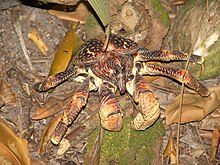| Coconut crab Temporal range: Neogene–present,
| |
|---|---|

| |
| Scientific classification | |
| Domain: | Eukaryota |
| Kingdom: | Animalia |
| Phylum: | Arthropoda |
| Class: | Malacostraca |
| Order: | Decapoda |
| Suborder: | Pleocyemata |
| Infraorder: | Anomura |
| Family: | Coenobitidae |
| Genus: | Birgus Leach, 1816 |
| Species: | B. latro
|
| Binomial name | |
| Birgus latro | |

| |
| Coconut crabs live on most coasts in the blue area; red points are primary and yellow points secondary places of settlement | |
| Synonyms[3] | |
The coconut crab (Birgus latro) is a terrestrial species of giant hermit crab, and is also known as the robber crab or palm thief. It is the largest terrestrial arthropod known, with a weight of up to 4.1 kg (9 lb). The distance from the tip of one leg to the tip of another can be as wide as 1 m (3 ft 3 in). It is found on islands across the Indian and Pacific Oceans, as far east as the Gambier Islands, Pitcairn Islands and Caroline Island and as far west as Zanzibar. While its range broadly shadows the distribution of the coconut palm, the coconut crab has been extirpated from most areas with a significant human population such as mainland Australia and Madagascar.
The coconut crab is the only species of the genus Birgus, and is related to the other terrestrial hermit crabs of the genus Coenobita. It shows a number of adaptations to life on land. Juvenile coconut crabs use empty gastropod shells for protection like other hermit crabs, but the adults develop a tough exoskeleton on their abdomens and stop carrying a shell. Coconut crabs have organs known as branchiostegal lungs, which they use for breathing instead of their vestigial gills. After the juvenile stage, they will drown if immersed in water for too long. They have an acute sense of smell which they use to find potential food sources, and which has developed convergently with that of insects.
Adult coconut crabs feed primarily on fleshy fruits, nuts, seeds, and the pith of fallen trees, but they will eat carrion and other organic matter opportunistically. Anything left unattended on the ground is a potential source of food, which they will investigate and may carry away – thereby getting the alternative name of "robber crab". The species is popularly associated with the coconut palm, yet coconuts are not a significant part of its diet. Although it lives in a burrow, the crab has been filmed climbing coconut and pandanus trees. No film shows a crab selectively picking coconut fruit, though they might dislodge ripe fruit that otherwise would fall naturally. When a crab is not near its burrow, climbing is an immediate escape route from predators. Sea birds eat young crabs, and both humans and larger, older crabs eat crabs of all ages.
Mating occurs on dry land, but the females return to the edge of the sea to release their fertilized eggs, and then retreat up the beach. The larvae that hatch are planktonic for 3–4 weeks, before settling to the sea floor, entering a gastropod shell and returning to dry land. Sexual maturity is reached after about 5 years, and the total lifespan may be over 60 years. In the 3–4 weeks that the larvae remain at sea, their chances of reaching another suitable location is enhanced if a floating life support system avails itself to them. Examples of the systems that provide such opportunities include floating logs and rafts of marine or terrestrial vegetation. Similarly, floating coconuts can be a very significant part of the crab's dispersal options.[4] Fossils of this crab date back to the Miocene.[5]
- ^ Cumberlidge, N. (2020). "Birgus latro". IUCN Red List of Threatened Species. 2020: e.T2811A126813586. doi:10.2305/IUCN.UK.2020-2.RLTS.T2811A126813586.en. Retrieved 19 November 2021.
- ^ Cite error: The named reference
McLaughlin2010was invoked but never defined (see the help page). - ^ Cite error: The named reference
McLaughlin2010bwas invoked but never defined (see the help page). - ^ Harries, H.C. (1983). "The coconut palm, the robber crab and Charles Darwin". Principes. 27 (3): 131–137.
- ^ "Birgus latro Linnaeus 1767 (hermit crab)". PBDB.org.
